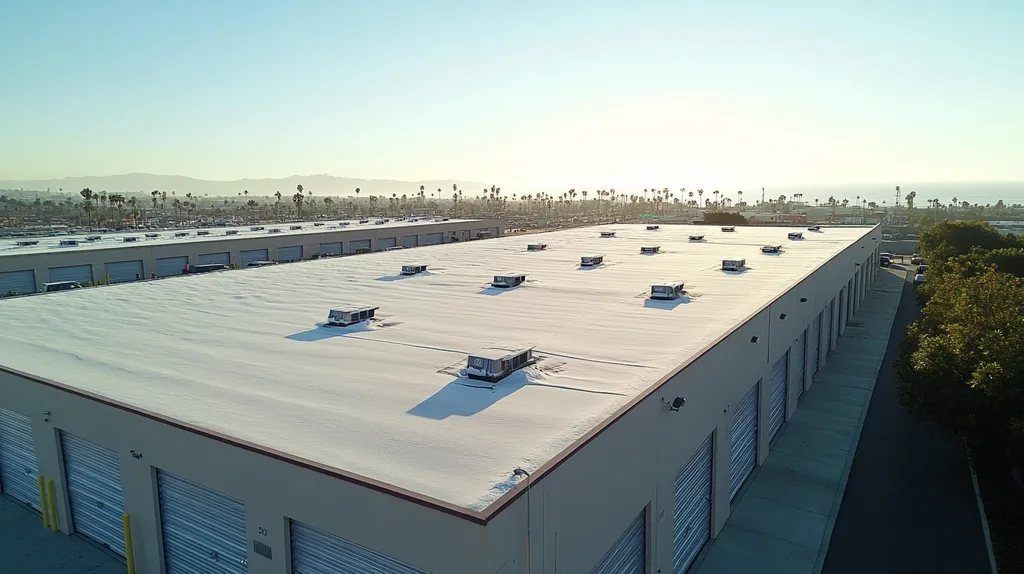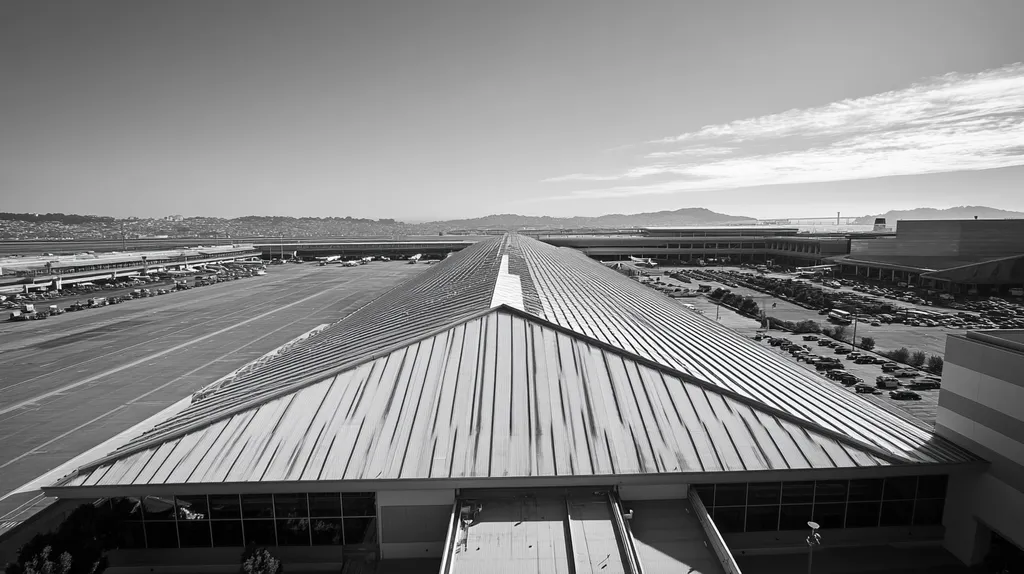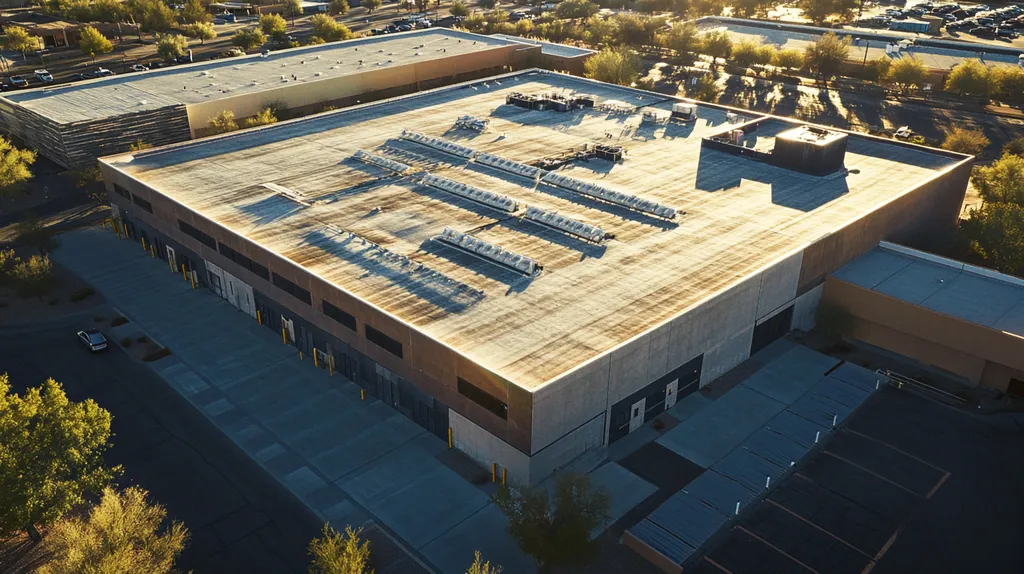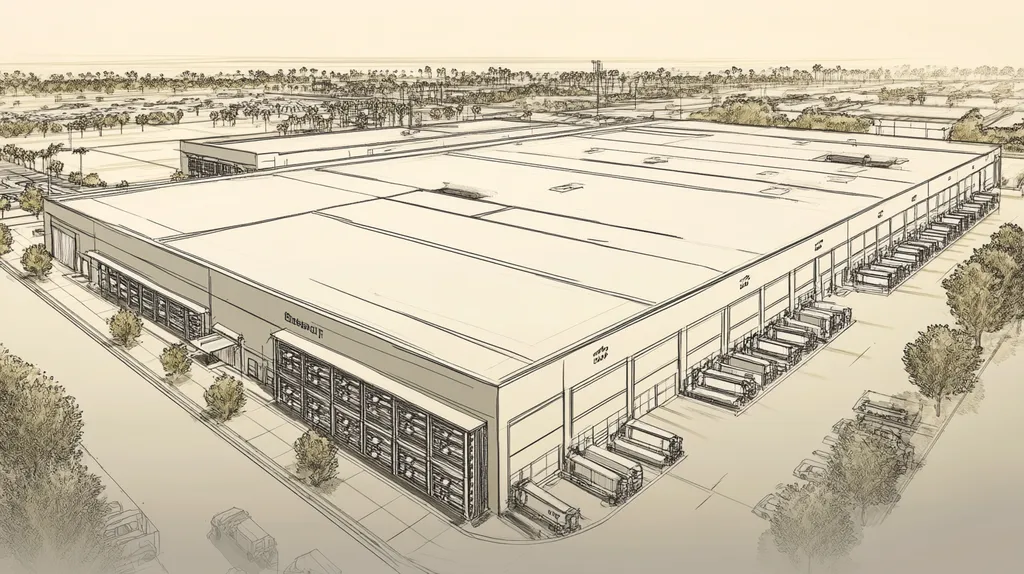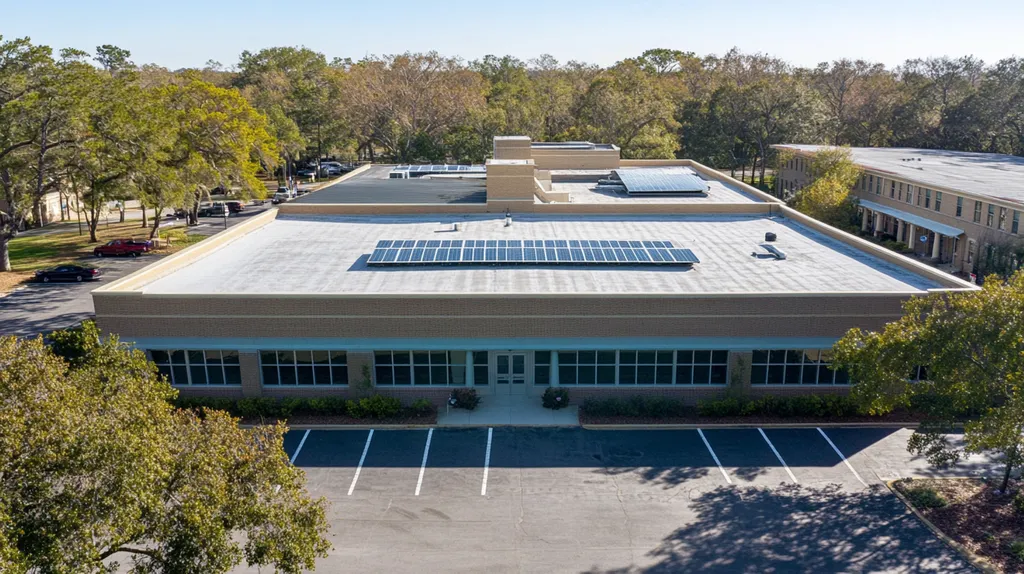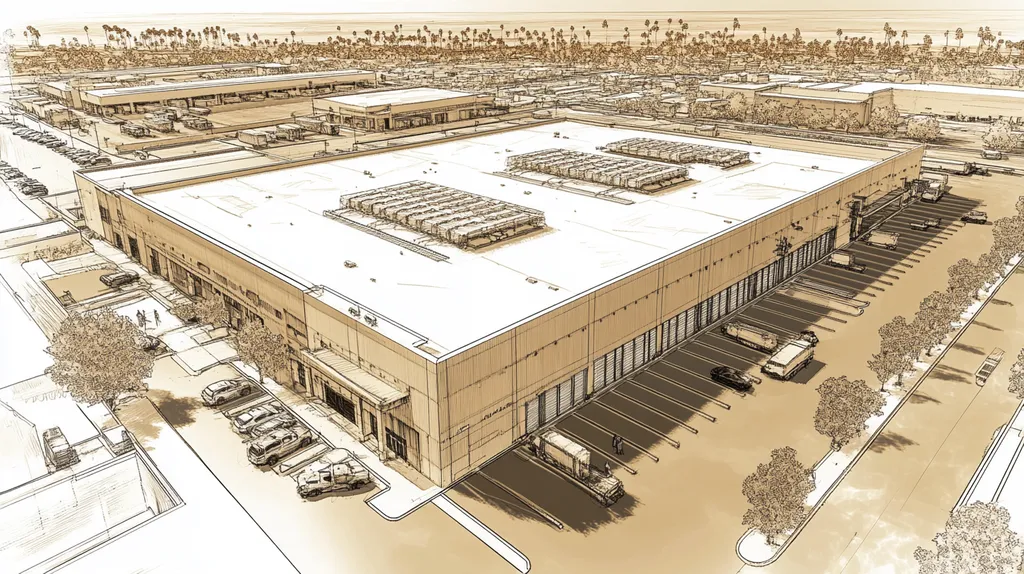For commercial property managers, roof maintenance isn’t just another checkbox—it’s a critical defense against catastrophic failure. Industry data shows that 90% of premature roof failures stem from inadequate maintenance, with repair costs averaging $15 per square foot when problems are ignored.
While vendors pitch increasingly complex “smart” solutions, the fundamentals of routine checks remain unchanged: systematic inspection, proactive repairs, and proper documentation.
This guide cuts through the hype to deliver actionable insights on implementing an effective roof maintenance program that maximizes longevity while minimizing costs.
SECTION 1: THE BASICS EXPLAINED
Commercial roof maintenance isn’t just a nice-to-have—it’s an absolute must-do. Ignoring routine checks can lead to catastrophic failures like leaks or full-on structural collapses. Research shows that a roof that’s periodically inspected can last up to 50% longer than one that’s left to its own devices. It’s clearly in a property owner’s best interest to stay proactive.
Grasping the fundamentals of routine roof checks empowers property managers to make savvy choices that can significantly enhance roof life. This section will break down what these checks entail, why they’re so crucial, and how to set them up effectively.
What It Is (In Plain Language)
Routine roof maintenance is all about staying ahead of the game with regular inspections and necessary upkeep. In layman’s terms, it means checking the roof for signs of wear and tear, clearing away debris, and making sure all components are working properly.
This routine includes a thorough assessment of the roofing materials, flashings, drainage systems, and ventilation. By nipping minor issues in the bud, property managers can skirt major repairs and extend the roof’s lifespan considerably.
For example, a straightforward inspection might uncover that roofing seams are beginning to loosen. Catching this early allows for a quick fix that can stop water from sneaking in and causing costly interior damage.
It’s recommended to conduct these checks at least twice a year—ideally in spring and fall—and right after major weather events. Think of these checks as routine health screenings for commercial roofs.
Why It Matters (To Your Building)
The stakes for routine checks couldn’t be higher. A well-maintained roof is your building’s frontline defense, safeguarding both its structural integrity and occupant safety. For commercial properties, a compromised roof can mean hefty repair bills, legal liabilities, and lost business opportunities.
Moreover, regular inspections can play a significant role in enhancing energy efficiency. Roof leaks and insulation problems can lead to inflated energy bills, costing businesses dearly. In fact, investing in roof maintenance can shave up to 20% off energy costs.
And let’s not overlook the insurance angle. Many insurers demand documented maintenance records to validate claims. Skipping routine checks can lead to unexpected expenditures and headache-inducing insurance disputes. Property managers must prioritize roof upkeep to avoid these pitfalls.
Considering that a commercial roof represents a considerable financial investment, routine checks are essential for asset protection and management, ensuring a solid return on investment over time.
How It Works
Implementing routine checks is a structured process, guided by schedule and methodology. It kicks off with a comprehensive visual inspection conducted by a qualified roofing professional. This inspection aims to spot signs of wear, damage, and any debris that could hamper drainage.
Next up, essential maintenance tasks, like cleaning gutters and downspouts, are tackled. This step is crucial to preventing water accumulation that could lead to leaks or accelerate roofing material deterioration. Additional protective coatings might also be applied to boost the roof’s longevity.
Once the inspection wraps up, a detailed report is created, outlining any findings and suggesting next steps. This documentation is not just for show—it’s vital for tracking maintenance history and budgeting for future repairs.
Finally, scheduling regular follow-up inspections ensures that roofs remain sound over time. By taking this disciplined approach, property managers can effective guard their investment and maximize roof longevity.
SECTION 2: PRACTICAL APPLICATIONS
In the high-stakes world of commercial property management, routine roof maintenance isn’t just a suggestion; it’s vital for safeguarding your investment. The National Roofing Contractors Association reveals a staggering statistic: over 70% of roofing failures stem from neglecting maintenance. Skipping routine checks can lead to costly repairs, unforeseen leaks, and premature roof replacements. This section dives into the everyday benefits of routine checks, pinpointing when they’re crucial, and explaining how roof maintenance interacts with other building systems.
Common Uses & Examples
Routine roof checks serve multiple critical functions, acting like a proactive doctor for your property. These inspections can identify issues such as punctures, blisters, and drainage problems before they spiral into major headaches. Property managers should prioritize bi-annual checks to keep the roof performing at its best.
Different roofing types, from TPO to EPDM to built-up roofs, have their specific maintenance needs. For example, TPO roofs demand special attention to their seam integrity, while built-up roofs require consistent checks for gravel displacement.
Routine checks are also an opportunity to clear debris and remove any overhanging tree branches that pose a risk. By tackling these concerns promptly, property managers can significantly extend the roof’s lifespan.
Furthermore, a well-logged inspection process provides invaluable documentation that can prove essential for warranty claims or enhancing the property’s resale value in the future.
When You Need It Most
Timing is everything when it comes to roof maintenance. The most critical inspections should happen before and after severe weather events. Storms can cause unexpected damage, making it essential to assess the roof afterwards to avoid further complications.
The changing seasons also place stress on roofing materials as they expand and contract. Therefore, conducting thorough inspections in spring and fall is a smart strategy to catch potential issues related to temperature shifts.
Particular vigilance is necessary after extreme weather events. Statistics indicate that 40% of roof damage claims originate from severe storms. Thus, speedy inspections are crucial to mitigating costs and ensuring the roof remains structurally sound.
Interactions With Other Systems
A commercial roof doesn’t act alone; it interacts with various building systems such as HVAC, drainage, and insulation. Inspections can reveal how these systems impact roof performance and longevity.
For instance, a malfunctioning HVAC unit can lead to excess condensation on the roof, creating an environment ripe for mold and water damage. Regular checks enable property managers to identify and address issues before they escalate.
Equally important is ensuring drainage systems are functioning properly. Clogged drains can result in stagnant water, jeopardizing the integrity of roofing materials.
Maintaining harmony between the roof and other building systems is essential for long-term reliability. Coordinated inspections can uncover weaknesses across the entire structure, ensuring that every component contributes positively to roof health.
SECTION 3: KEY TERMINOLOGY DECODED
Grasping roofing terminology isn’t merely academic—it’s a linchpin for effective maintenance management. Misunderstandings can snowball into financial nightmares, where a minor leak can escalate into a full-blown structural disaster costing thousands. This section demystifies key terms, navigates through industry jargon, and simplifies vital measurements, empowering property managers to make smart, informed decisions about their roofs.
Essential Terms Explained
Understanding terms like “thermal expansion” and “drainage systems” is crucial for effective roof management. Thermal expansion refers to how roofing materials, like a rubber band, stretch and shrink with temperature fluctuations. Knowledge of this concept aids in choosing materials that can withstand local climate variations.
Drainage systems play a vital role in keeping roofs water-free and structurally sound. Familiarizing yourself with terms such as “scuppers” and “downspouts” provides insight into how water flows off a roof and prevents unwanted buildup.
Property managers should also understand “substrate,” which is the underlying material lying beneath the roof covering. This base material significantly influences insulation performance and overall roof durability.
Don’t forget essential terms like “flashing,” the protective layer that seals joints to stop water from sneaking in, and “membrane,” which is essentially the skin of the roof. Mastering these basics is essential for effective roof management.
Industry Jargon Translated
The roofing industry is rife with jargon that can confound even the most seasoned property managers. For instance, “R-value” measures a roof’s thermal resistance, giving insight into its energy efficiency. A higher R-value means better insulation and lower energy costs—something every manager wants to maximize.
Measurement & Units Simplified
Navigating measurement units can feel intimidating, but they’re essential for evaluating roofing needs. Square footage is often used to measure roofing area, making it necessary to learn how to calculate this correctly for material estimation and cost planning.
SECTION 4: DECISION FACTORS
Making smart choices about commercial roof maintenance isn’t just a dashboard issue—it’s a survival tactic. Skipping maintenance can lead to wallet-draining repairs and the plummet of your property’s value. For instance, a seemingly minor leak can snowball into a major fiasco, wreaking havoc on operations and lines of revenue. To effectively manage roofing routines, property managers must weigh cost implications, performance trade-offs, and material lifespan. Each element plays a vital part in guaranteeing a roof that’s reliable, effective, and not a money pit.
Cost Considerations
Budget constraints are a reality that all property managers face, but slashing maintenance funds is a risky gamble. Evaluating the immediate costs against future savings is crucial. Yes, regular inspections might feel like an expense, but they can be your insurance against catastrophic failures down the line.
For example, bringing in a pro for scheduled inspections can identify sneaky issues like hidden degradation or unnecessary membrane wear long before they spiral out of control. Tackling these issues early can lead to precision repairs instead of the wallet-emptying horror of total replacements.
Let’s not forget that the price of a maintenance program is small change compared to the potential income losses from roof failures. Skipping checks could jeopardize occupancy rates and disrupt day-to-day operations.
Research shows that for every dollar put into roof maintenance, businesses can avoid costs of four to six times that amount. Now that’s a smart investment! (source: Travelers Insurance)
Performance Trade-offs
The effectiveness of roofing systems heavily relies on the quality of maintenance performed. Property managers are often caught in a tug-of-war between cutting costs and ensuring effective repairs. Choosing quick and cheap fixes may lead to a maintenance nightmare down the road.
Using substandard materials for a “bargain” solution can result in poor roof performance, affecting insulation and driving up energy costs. A roof that is taken care of properly should ideally help keep those utility bills in check.
In addition, these trade-offs have a long-term impact on durability. Proactive maintenance helps extend the lifespan of the roof, managing destructive factors like water accumulation and debris build-up. The choice of good maintenance can separate a roof lasting two decades from one that might flop after just a decade.
In the end, property managers should adopt a balanced strategy that prioritizes quality repairs over merely chasing price tags—it’s an investment in both durability and performance.
Lifespan & Durability Factors
The longevity of a commercial roof is intimately tied to the routine maintenance practices employed. Each roofing material comes with its own life expectancy, and neglecting care can slash that by years. For instance, a TPO roof may hang in there for two decades if treated right, but neglect can cut that number to a dismal ten.
External conditions also come into play. Weather extremes like heavy rain or hail can accelerate wear and tear. Routine checks and on-time repairs create a bulwark against such elements, ensuring your roof holds strong.
Additionally, the quality of installation influences durability more than many property managers realize. A poorly installed roof might not even reach its intended lifespan, regardless of how well it’s maintained. Thus, a commitment to high installation standards is crucial—just as important as the maintenance plan itself.
Recognizing the interplay between routine maintenance and durability means maximizing roofing investments—leading to a robust, reliable roof that delivers returns over time.
SECTION 5: COMMON CHALLENGES
Neglecting routine checks in commercial roofing is a ticking time bomb waiting to explode. The stakes are high: failure to maintain can lead to costly repairs, drastic structural issues, or even complete failure of the roof. In fact, a staggering 80% of roofing problems stem from a lack of regular maintenance. This section delves into common pitfalls, glaring warning signs, and effective preventative strategies that can save property managers both headaches and cash.
Frequent Problems & Solutions
Common problems can easily wreak havoc on commercial roofs, including leaks, punctures, and blistering. These issues often arise from environmental nightmares, such as heavy rain or extreme temperature fluctuations. For instance, standing water can trigger a parasitic relationship with roofing materials, leading to ponding and degradation over time.
Proactive inspections are the key to identifying these headaches before they snowball. Roofing technicians should closely examine seams and flashings, as these are vulnerable points where leaks often occur. Timely patching and repairs can effectively address punctures, while ensuring proper drainage will keep standing water at bay.
Regular maintenance checks are crucial, especially after severe weather events. Addressing minor issues promptly prevents them from escalating into major crises. A swift fix can save a building’s integrity from costly damage.
Additionally, investing in roofing membranes engineered to handle temperature swings can significantly reduce the chances of blistering. Consider applying reflective coatings to mitigate thermal stress and extend the lifespan of your roof.
Warning Signs To Watch For
Awareness of early warning signs is essential for timely intervention. Discoloration or sagging in the roofing surface often indicates lurking problems beneath the surface. Such changes shouldn’t be ignored, as they potentially point to moisture infiltration or structural compromise.
Mold or mildew presence is another red flag that shouldn’t go unnoticed. These culprits not only harm indoor air quality but can also warp roofing materials and weaken structural supports over time.
Water stains on ceilings or walls are often a cry for help, signaling leaks that require immediate attention. If allowed to fester, these leaks can skyrocket repair costs.
Lastly, cracks in roof seams or visible detachment of roofing materials are glaring indicators that action is needed. Facility managers must prioritize these observations, scheduling quick inspections to diagnose and remediate issues before they worsen.
Preventative Approaches
Preventative maintenance isn’t just smart; it’s essential for avoiding common roofing challenges. Regular inspections should happen at least twice a year and immediately following major storms. Engaging a qualified roofing contractor for these inspections ensures a thorough assessment of any potential issues.
Creating a routine maintenance checklist simplifies the process. This checklist might include checking seals, clearing drains, and examining roof edges for wear and tear. A structured approach minimizes the risk of overlooking critical tasks.
Investing in advanced roofing technology can provide additional layers of protection. For instance, infrared thermography can identify hidden moisture issues that visual inspections might miss.
Scheduling regular cleanings is another simple yet effective way to maintain the roof’s integrity. A clear roof reduces the chances of pooling water and subsequent damage, keeping roofing systems in optimal condition.
SECTION 6: NEXT STEPS & RESOURCES
Time’s ticking on roof maintenance, and procrastination can sink a property manager’s budget faster than a heavy storm. Ignoring routine checks invites disaster, given that a staggering 75% of roofing failures result from poor upkeep. For property managers, understanding how to engage with service providers—and where to find trustworthy information—is not just smart; it’s essential to safeguarding their investment.
Questions To Ask Providers
Before signing on the dotted line with a roofing service provider, property managers should come loaded with questions. First, delve into their experience with the specific roofing material in question. Remember, one size does not fit all when it comes to care. Also, inquire how often they conduct routine inspections and what their reporting process looks like.
Warranty details cannot be overlooked. Clear understanding of what maintenance is included will prevent unpleasant surprises later on. It’s a red flag if they can’t confirm that their practices align with industry standards.
Lastly, don’t shy away from asking for references from past clients. This is your chance to gauge satisfaction and reliability. Picking the right contractor could be the line between a well-maintained roof and a costly nightmare.
Industry Standards & Guidelines
Sticking to industry standards is non-negotiable for effective roof maintenance. The National Roofing Contractors Association (NRCA) lays out clear guidelines for property managers eager to keep their roofs in peak shape. These include ensuring regular inspections, clearing debris, and being vigilant about any signs of wear or damage.
Additionally, knowing the Occupational Safety and Health Administration (OSHA) regulations is vital. These not only protect workers but also shield property managers from legal liabilities. A failure to implement these guidelines could lead to some serious complications down the road.
Keeping abreast of the latest industry standards allows property managers to make smart decisions on repairs and replacements, ultimately safeguarding their assets and extending roof life.
Further Learning Simplified
Education isn’t a one-and-done deal; it’s an ongoing journey for property managers committed to roof maintenance. Countless online resources and webinars can help sharpen your skills. The NRCA provides training programs on everything from basic roof care to advanced inspection methods.
Attending industry conferences is another great avenue for fresh insights and trends in roofing. Networking with experts can inspire new approaches to maintenance strategies that really work.
Also, subscribing to industry publications keeps the information flow steady. Staying updated on trends and best practices empowers property managers to make informed decisions, fortifying their building assets for the long haul.
The Bottom Line
With 90% of premature roof failures traced directly to inadequate maintenance, the message is clear: routine checks aren’t optional—they’re essential for survival.
Property managers who implement systematic inspection programs can extend their roof’s lifespan by up to 50% while avoiding catastrophic repair costs that average $15 per square foot when issues are ignored.
Despite vendors pushing increasingly complex “smart” solutions, successful roof maintenance still comes down to three fundamentals: regular professional inspections, swift repairs when needed, and proper documentation.
The choice is stark: invest in routine maintenance now or pay exponentially more for emergency repairs later.
For commercial properties, this isn’t just about protecting an asset—it’s about ensuring business continuity and occupant safety for years to come.
FREQUENTLY ASKED QUESTIONS
Q. Why is commercial roof maintenance crucial?
A. Regular roof maintenance prevents serious issues like leaks and structural failures. It extends the roof’s lifespan significantly and protects your investment. Skipping routine checks can lead to costly repairs and damage to other building systems.
Q. When should I perform inspections on my industrial roof?
A. Inspections should occur at least twice a year, ideally in spring and fall. Additionally, always check after severe weather events. This ensures that any storm-related damage is caught early, saving you from bigger issues down the road.
Q. What are key terms every property manager should know about commercial roofs?
A. Essential terms like “thermal expansion,” “drainage systems,” and “flashing” are vital. They are crucial for understanding how roofing materials react to environmental changes and how to maintain effective drainage, which prevents leaks and damage over time.
Q. How can I make smart decisions about commercial roof maintenance?
A. Weigh the costs of maintenance against potential future repairs. Choose high-quality materials for longevity, and invest in regular inspections to catch issues early. Balancing cost and quality will pay off in durability and performance over time.
Q. What common challenges do property managers face with roof maintenance?
A. Common challenges include leaks, punctures, and neglecting warning signs. Awareness is half the battle—early detection can prevent costly repairs. Implementing regular inspections and creating a checklist can help mitigate these pitfalls effectively.
Q. What should I ask a roofing service provider before hiring?
A. Inquire about their experience with your specific roofing material and their inspection frequency. Understanding warranty details and asking for client references can also help ensure you’re hiring a qualified provider for your maintenance needs.
Q. How can nutrition affect my commercial roof’s performance?
A. Believe it or not, roof nutrition—like proper drainage and protection—matters. Keeping your roof well-maintained reduces erosion from elements and boosts longevity. Think of it as feeding your roof the right “diet” to keep it healthy and functional!

